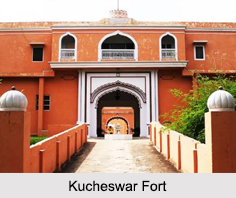 The 18th century Kuchesar Fort is located in the princely state of Kuchesar in Bulandshahr in the state of Uttar Pradesh. Presently, the fort has been transformed into a heritage hotel, which was formed by the restoration of a section of Ajit Singh`s ancestral property.
The 18th century Kuchesar Fort is located in the princely state of Kuchesar in Bulandshahr in the state of Uttar Pradesh. Presently, the fort has been transformed into a heritage hotel, which was formed by the restoration of a section of Ajit Singh`s ancestral property.
Etymology of Kucheswar Fort
The Kucheswar Fort is also known as the "Mud Fort". This is because the area surrounding the fort has about 100 acres of mangrove forests and it is believed the fort was originally constructed with the forests" mud.
History of Kucheswar Fort
Built in 1734 by the Kuchesar rulers, the Agori Fort was granted to Ramdhan Singh"s family in perpetual lease by the Mughal Emperor Shah Alam II in 1790, a grant confirmed later by the British. During the 18th century, the Kucheswar Fort was acquired by Ajit Singh"s family when the Naji ad-Dawlah bestowed the Jat family with the title of Rao Bahadur. In 1994, the fort was restored by Neemrana Hotels and turned into a heritage style hotel. The family occupies a portion of the hotel, including the former reception area and colonial style dining halls.
Visiting Information on Kucheswar Fort
The Bulandshahr railway station is the nearest at a distance of 47 km from the fort and the Pandit Deen Dayal Upadhyay Airport is the closest at a distance of 245 km from the Kucheswar Fort.
This article is a stub. You can enrich by adding more information to it. Send your Write Up to content@indianetzone.com.



















